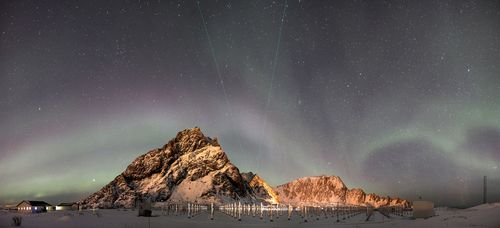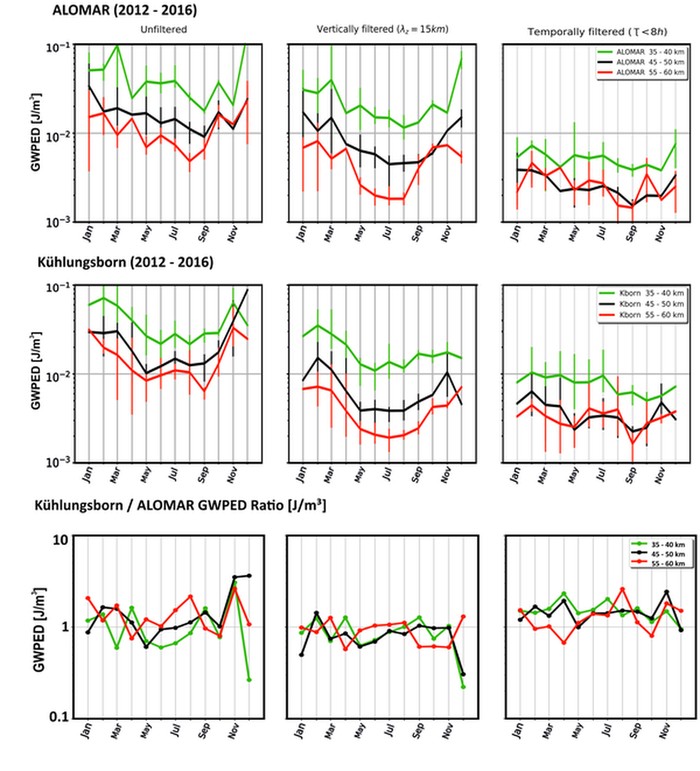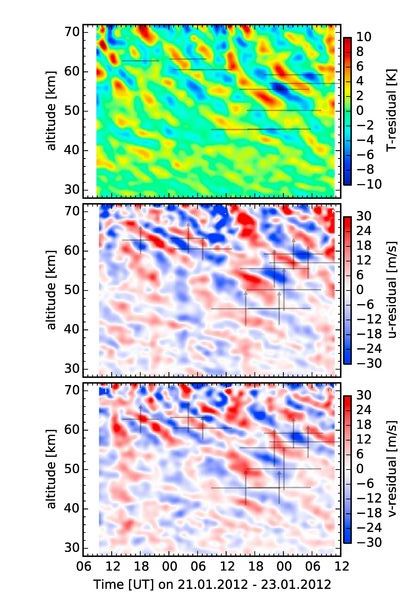Processes And Climatology Of Gravity waves (PACOG)
PIs:
Prof. Dr. Franz-Josef Lübken, Prof. Dr. Jorge Chau, Dr. Gerd Baumgarten, IAP Kühlungsborn,
Prof. Dr. Markus Rapp, Dr. Andreas Dörnbrack, IPA DLR Oberpfaffenhofen
PhD students and Postdocs:
Dr. Irina Strelnikova (IAP), Robert Reichert (DLR), Kathrin Baumgarten (IAP), Dr. Bernd Kaifler (DLR); Benedikt Ehard (DLR), Raimund Wörl (IAP)

PACOG is a project within the Research Unit MS-GWaves which is dedicated to the general study of gravity waves. PACOG concentrates on atmospheric observations and comparison with models.
Gravity waves play a key role in our understanding of the middle atmosphere since they drive the atmosphere away from radiatively determined conditions by up to 100 K and impose drastic changes on circulation systems and composition. They are the most important coupling mechanism from below to above. Unfortunately, many processes related to gravity waves are not well understood. This concerns, for example, generation, propagation, filtering, dissipation as well as seasonal and temporal variability. We intend to study the climatology of gravity waves on regional and global scales, and also their relevance for global processes. We will apply a combination of sophisticated and comprehensive instrumentation (lidars, radars, sensors on satellites, etc.) and will interpret our measurements with the help of related simulations based on reanalysis data. The final aim of MS-GWaves is to improve the parametrization of gravity waves used in global models. Observations performed in PACOG shall be used in all projects of MS-GWaves, for example when comparing local and regional measurements with global observations from satellites (SV project) or as benchmark tests for the validation of modeling in the 3DMSD and GWING projects.

In the first phase of the project the climatology of gravity wave potential energy density (GWPED) was obtained from the RMR lidar at Kühlungsborn during night- and daytime.
Apart from the DEEPWAVE campaign in New Zealand, a comprehensive field campaign was conducted in Northern Scandinavia in the winter of 2015/2016 which involved several lidars, radars, airglow instruments etc., as well as several aircraft and balloons. This was presumably the largest field campaign ever conducted in that region.
In the second phase we plan to investigate the temporal and spatial variability of tides and gravity waves, the importance of local sources ('hot spots') for GW effects in the strato/mesosphere, the importance of secondary GWs for the dynamics of the middle atmosphere, the GW coupling of troposphere/middle atmosphere during selected scenarios, and the dissipation of gravity waves.
The final aim of MS-GWaves is to improve the parametrization of gravity waves used in global models. Observations performed in PACOG shall be used in all projects of MS-GWaves, for example when comparing local and regional measurements with global observations from satellites (SV project) or as benchmark tests for the validation of modeling in the 3DMSD and GWING projects.


